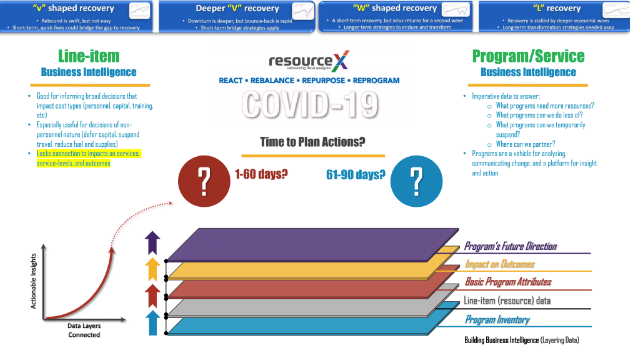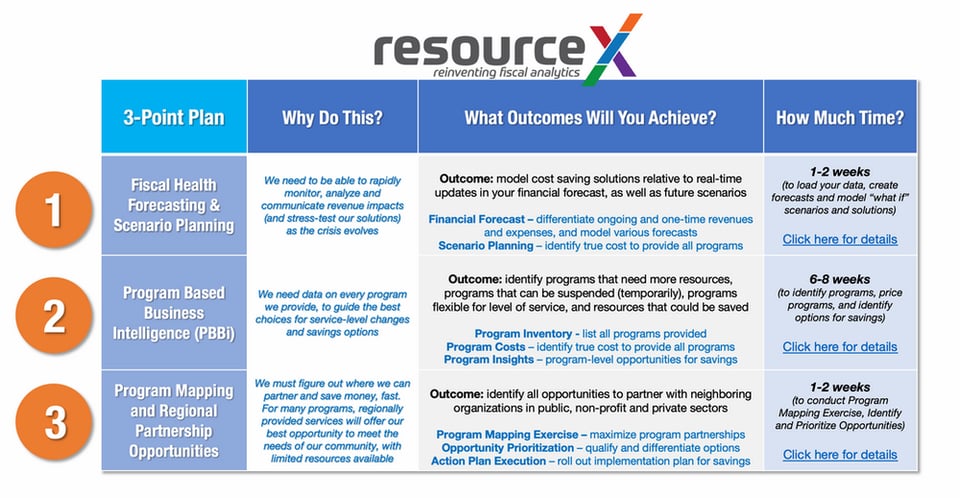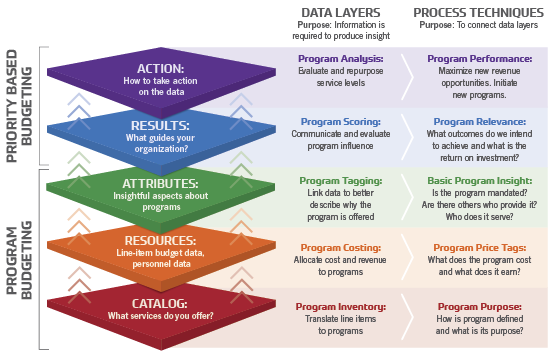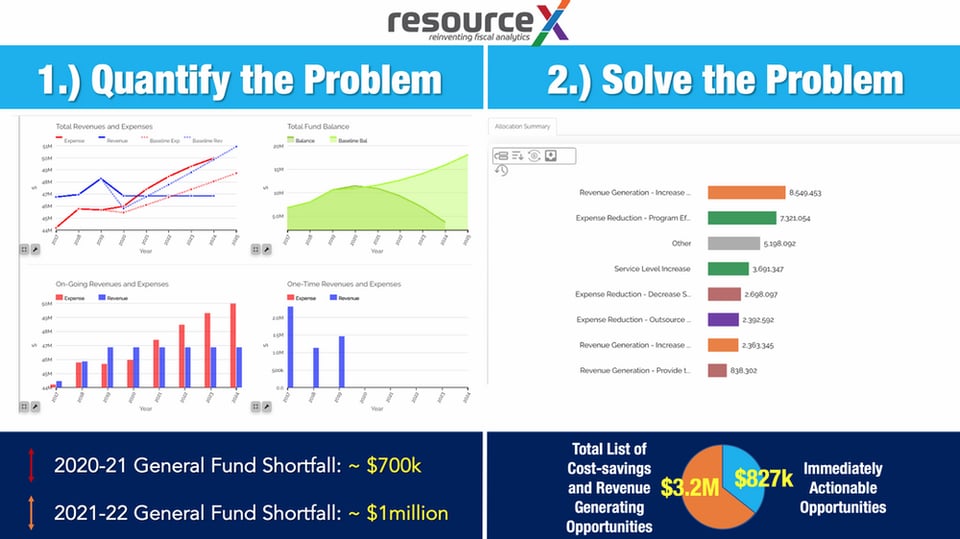The COVID-19 pandemic has created unprecedented challenges across the country. And while there will be more challenges in the days and weeks ahead, we are also planning for emerging from these challenges and how we can support our clients and partners in a strong recovery.
With all forms of local government facing unprecedented fiscal pressure (cities, counties, school districts, transit agencies, etc.), the time is now to address short-term crisis while simultaneously planning for a long-term rebound strategy (and ultimately flourishing).
ResourceX has established a series of strategies to assist in this effort. These strategies are not a silver-bullet and will not be easy, but are proven best-practices that have assisted local governments during the past recession and are actively being deployed to address major challenges during this pandemic crisis.
Webinar: Addressing the Municipal Fiscal Crisis: A 3-Point Plan
When: Wednesday, May 6, 2020 at 1 pm MT
Registration has expired. Please see webinar video recording below!
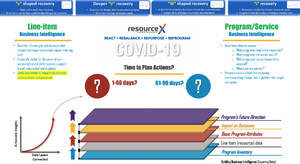
A 3-point Plan of Action
The disruption brought on by the COVID crisis is beyond anything most of our organizations have experienced in our lifetimes, and the situation is still evolving.
We believe organizations will need to adopt three skills for the foreseeable future in order to persevere through the crisis and beyond.
1.) First, we need to be able to rapidly monitor, analyze and communicate revenue impacts (and stress-test our solutions) as the crisis evolves. We’ll need to be able to update fiscal forecasts and potential future scenarios, adjusting for plausible fiscal impacts of new policies (which are all experiments) as they’re rolled out, and we’ll therefore have to continually update our playbook of solutions to be prepared for evolving scenarios.
Solution: Fiscal Health Forecasting & Scenario Planning
Fiscal Health Forecasting & Scenario Planning provides “data visualization” which allows local governments to create a common view of the financial situation that is simple to understand and interpret, describes the clearly defined variables that can impact the financial situation, allows for "live" and "real-time" changes in these variables, and offers the ability for "dynamic" modeling of "what-if" scenarios.
2.) Second, we need data on every program we provide, to guide the best choices for service-level changes and savings options – and we need this data as soon as possible, to plan for decisions that we’ll have to make within the next 6-8 months.
We’re going to need to have programmatic data to base decisions on – knowledge of every program offered, the cost of providing the program, level of service, cost recovery, degree of mandate in providing the program, opportunity to partner, etc.
a. Service-level choices (what services will need more resources, what services will we continue to offer, what services will we cease altogether or provide at a lesser level of service, and what services may we partner regionally to provide more economically) are what will be required after all of our other quick-strike strategies are exhausted.
b. Short-term, one-time, bridge-the-gap solutions to “buy time” (like deferring capital projects, furloughs, pay-freezes, tapping reserves), while appropriate to survive and keep afloat in the near-term, are only sustainable in a rapid bounce-back scenario where the virus is contained permanently by summer, the economy reopens and returns to pre-crisis levels of productivity (not likely).
c. Most organizations will have already exhausted these immediate solutions to survive the first wave of economic set-backs from the first round of shelter-in-place policies deployed to “flatten the curve.”
d. For any scenario that emerges that is worse than the “best case” scenario of a vaccine by summer (including a “W” scenario including resurgence of the virus in the fall/winter requiring another round of shelter-in-place and business closure, and/or an “L” scenario which would entail a long-term recession / depression); local government managers will need strategies and solutions to optimize expenses within revenue constraints made substantially tighter and tighter – this will require fundamental choices as to:
i. what services will need more resources,
ii. what services will we continue to offer,
iii. what services will we cease altogether or provide at a lesser level of service, and
iv. what services may we partner regionally to provide more economically
e. Local governments may have 6-8 months before economic impacts from a “W” or “L” scenario would hit and require programmatic choices. Therefore, there is a short-window of time (the next 3-6 months) to assemble programmatic data in order to be prepared with a plan of action as to service-level choices that would have to be made.
Solution: Program Based Business Intelligence (PBBi)
Program Based Business Intelligence (PBBi) is the foundational data set for data-driven decision-making. PBBi builds on and makes use of your line-item data to create more actionable insights at the program level.
PBBi is the foundational data set that unlocks insights pertaining to program efficiency, service levels, and cost recovery opportunities, and that’s why it’s a Best Practice. PBBi date brings you actionable business intelligence through:
• Program Inventory – Translate line-items to programs and establish a master program inventory
• Program Costing – Assign personnel and non-personnel costs (including FTE) to each program to establish fully-loaded cost of program delivery
• Scoring/Evaluation – Assess and identify “impact on desired program outcomes”
• Program Data & Insights – Establish Basic Program Attributes for each program including level of mandate, opportunity for partnership, demand for service, cost recovery, etc.
• Blueprint for Action – Assess each program through the PBB Blueprint to determine future-focused direction for each program (reduce funding, decrease service levels, provide through a partnership, increase funding, etc.)
• Applying Data – Take action and execute program recommendations; repurpose funding for programs that deliver proven results and maximum impact
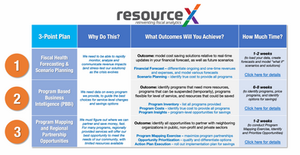
3.) Third, we must figure out where we can partner and save money, fast. For many programs, regionally provided shared services will offer our best opportunity to meet the needs of our community, with limited resources available. There may be no other way for a local government to offer full range service on it’s own, unless they leverage regional partners in the public, non-profit and private sectors.
Perhaps we may continue to provide our highest priority services independently (police, infrastructure , water etc). For others, we may so very little resources left over; if the choice was between: running this program with 50% of the resources we had provided it with before, versus b.) regionalizing the program (even if for a short term period of time) with another jurisdiction or a consortium of regional partners, would we be better off with a or b?
We believe regional solutions offer an immensely powerful opportunity for local governments – the challenge is how to maximize these opportunities and implement them.
Solution: Program Mapping
Organizations participating in a Program Mapping initiative come to identify the services they share in common (“match up”) with local governments, non-profits and private sector entities in their region. Service-sharing opportunities in common are then to be characterized in terms of partnership, merged/consolidated services, in-sourced regionally provided services, or out-sourced opportunities from the perspective of each participant. And finally, these opportunities are further characterized and prioritized in terms of the magnitude of complexity in implementing a shared-service approach, and the value of the opportunity if it were to be realized.
Call to Action
When crisis strike local governments, many find themselves unprepared for the resultant fiscal challenges and distress. Rather than resorting to the traditional response of merely cutting all budgets by a flat percentage, there are other tools and approaches to fiscal survival that are available.
Implementing a 3-Point Plan for ensuring that forecasting, programmatic based business intelligence and an openness for intergovernmental collaboration will help build resilience for organizations in distress. As opposed to a stress response in the face of a crisis, ResourceX offers the confidence of a proven means for assisting a local government achieve fiscal sustainability.
Register and learn how to establish your 3-point plan for your organization!
